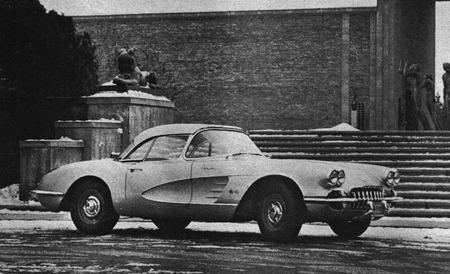Originally published in Sports Cars Illustrated in March 1959.
With each annual change, Zora Arkus-Duntov, the Corvette’s godfather, has emphasized performance improvements. His theory is that to sell, the Corvette must first go. Styling has had its innings, too, but they have acted with more restraint than one expects from Detroit.
Perhaps in acknowledgement to the discriminatory taste of the sports car market, external changes for ’59 were of a customizing nature only. The washboard-like, phony louvers on the hood and the Pontiac-like silver streaks on the trunk lid are now things of the past. Inside, there are recontoured seat cushions, a reverse lock on the four-speed’s shift lever and an open-at-the-top catch-all which fills the opening in front of the “sissy-bar”. Also the doorknob and armrest have been moved. Engineering changes at the rear include newly added longitudinal radius rods to prevent axle wind-up and rearranged and recalibrated shock absorbers.
In discussing the new seats with Mr. Duntov, he pointed out that this is one of the most difficult compromises to make in a high-performance car. “In a racing car, the seat is 100% for working, just like a stool by a lathe. But in a passenger car, you’re lucky if it’s a ‘work chair’ more than 10% of the time. It must be easy to get in and out of, and comfortable for lounging in. The high sides of a real bucket seat are just right for holding you in place but they don’t meet these other requirements.”
Opening the trunk, later, we discovered an experimental seat cushion. We tried it and found it lets you sit a lot lower, accentuating the side support of the cushion edges and increasing headroom, too. The secret is foam rubber in place of the usual coil springs, the drawback is that it bottoms out too quickly on large bumps-sooner than the suspension. Oh, well, back to the drawing board.
Commenting on the door handles, Mr. Duntov pointed out that after driving Corvettes for thousands of miles on the Proving Grounds, he decided to move them forward during a visit to Riverside, California when he had to borrow a raincoat (?). The one he got had cinch-straps on the sleeves and he kept opening the door when turning left!
The sissy bar is unfairly named, it’s really quite the thing for hanging on when the driver is trying to prove something or other. The trash tray appeals to us, too, though others have condemned it as unsafe. We suspect that someone must have been road testing with their knees tucked under their chin because it just isn’t that low.
The world’s largest producer of automobiles, Chevrolet offers not just a wide range of models, but a staggering array of optional equipment on each model. As on the sedans, so on the Corvettes. Five variations on the 283 V8 theme are offered, three transmissions (two, three, and four speeds), four final-drive ratios, three brake lining choices and two suspensions, just to name the mechanical ones.
There is some interlocking involved, for instance, you can’t order the Positraction limited slip differential with Powerglide; the latter must have the 3.55/1 rear end and cannot have the 290 hp version of the Fuel Injection engine. On the other hand, the stiff suspension is available only in combination with the latter engine and Positraction.
For this test, the editors of SCI checked through the list of equipment options, nominating those we thought would add up to the most desirable all-around Corvette that you can buy. We had in mind, not the all-out racing version sampled in the December issue but a happy compromise that would be suited to both serious traffic and casual racing.


Leave a Reply